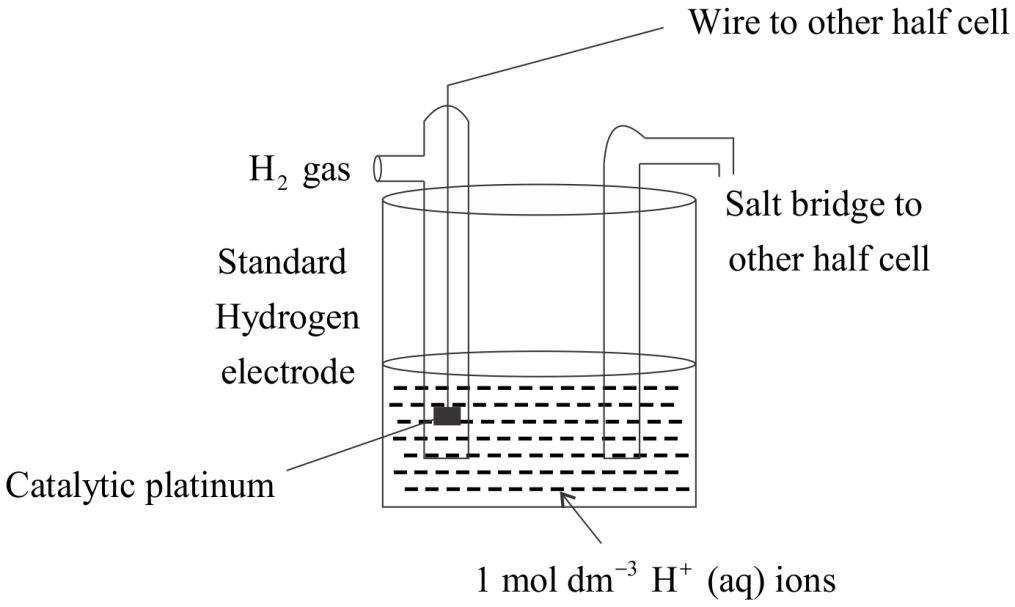
What is SHE? Explain its construction and application.
Answer
513.1k+ views
Hint: ${\text{SHE}}$ stands for standard hydrogen electrode. The standard hydrogen electrode is used in half cells as a reference electrode for determining the electrode potential. SHE has zero electrode potential at the temperature of \[298K\].
Complete step by step answer:
The standard hydrogen electrode is an electrode which is used in laboratory for measurement of electric potential of other electrodes in comparison to SHE at the same temperature that is \[298K\] SHE is based upon the redox half-cell, whose reaction is:
\[2{H^ + }\left( {aq} \right) + 2{e^ - } \to {H_2}\left( g \right)\]
In this process, a platinum electrode is used which is dipped in an acidic solution. Upon reaction, hydrogen gas is bubbled out. In the reaction, the concentration of both oxidized as well as reduced hydrogen is maintained at unity.
Construction of SHE is done as shown in the figure:

SHE consists of:
A platinum electrode covered in platinum black.
A hydrogen blow.
Acidic solution of concentration \[1\] mole \[d{m^{ - 3}}\]
It is also connected to another half life cell of the galvanic cell.
Application of SHE are:
SHE is used as an anode or cathode half cell
SHE is used to measure the potential of other electrodes. The unknown potential in this case would be equal to the EMF (Electromotive force) of the cell.
SHE also have some disadvantages such as:
It is difficult to construct, transport and maintain a SHE.
Pure hydrogen gas is yielding with difficulty.
The platinum electrode easily gets spoiled due to the presence of impurities.
Note:
A platinum electrode is used in SHE because of various reasons such as:
It forms an inert electrode, so the platinum itself does not participate in the reaction.
Platinum is a good absorber of \[{H_2}\] gas and helps in improving the chemical kinetics of the process.
Complete step by step answer:
The standard hydrogen electrode is an electrode which is used in laboratory for measurement of electric potential of other electrodes in comparison to SHE at the same temperature that is \[298K\] SHE is based upon the redox half-cell, whose reaction is:
\[2{H^ + }\left( {aq} \right) + 2{e^ - } \to {H_2}\left( g \right)\]
In this process, a platinum electrode is used which is dipped in an acidic solution. Upon reaction, hydrogen gas is bubbled out. In the reaction, the concentration of both oxidized as well as reduced hydrogen is maintained at unity.
Construction of SHE is done as shown in the figure:

SHE consists of:
A platinum electrode covered in platinum black.
A hydrogen blow.
Acidic solution of concentration \[1\] mole \[d{m^{ - 3}}\]
It is also connected to another half life cell of the galvanic cell.
Application of SHE are:
SHE is used as an anode or cathode half cell
SHE is used to measure the potential of other electrodes. The unknown potential in this case would be equal to the EMF (Electromotive force) of the cell.
SHE also have some disadvantages such as:
It is difficult to construct, transport and maintain a SHE.
Pure hydrogen gas is yielding with difficulty.
The platinum electrode easily gets spoiled due to the presence of impurities.
Note:
A platinum electrode is used in SHE because of various reasons such as:
It forms an inert electrode, so the platinum itself does not participate in the reaction.
Platinum is a good absorber of \[{H_2}\] gas and helps in improving the chemical kinetics of the process.
Recently Updated Pages
Why are manures considered better than fertilizers class 11 biology CBSE

Find the coordinates of the midpoint of the line segment class 11 maths CBSE

Distinguish between static friction limiting friction class 11 physics CBSE

The Chairman of the constituent Assembly was A Jawaharlal class 11 social science CBSE

The first National Commission on Labour NCL submitted class 11 social science CBSE

Number of all subshell of n + l 7 is A 4 B 5 C 6 D class 11 chemistry CBSE

Trending doubts
Differentiate between an exothermic and an endothermic class 11 chemistry CBSE

10 examples of friction in our daily life

One Metric ton is equal to kg A 10000 B 1000 C 100 class 11 physics CBSE

Difference Between Prokaryotic Cells and Eukaryotic Cells

State the laws of reflection of light

Explain zero factorial class 11 maths CBSE




